As I worked through the three categories in this domain, I did the reflections from the broad perspective starting with classroom culture to pedagogical effectiveness and then finally differentiated instructions. The classroom culture is about building relationship and trust so that the classroom is a safe place to ask questions and make mistakes. Pedagogical effectiveness is grounded in my philosophy or “Less me. More them.” So in nearly every lesson, I try to spend less time talking and provide opportunities for students to spend more time doing. The nitty-gritty then is the differentiated instruction and assessment were both the students and myself are accountable for each individual student’s learning goals.
Classroom Culture
To me, classroom culture is everything. My design of curriculum is centered around developing and maintaining a classroom culture where students feel safe to make mistakes, be vulnerable in front of their peers and can have fun in their process of learning. When designing the beginning of the year, I make purposeful efforts for students to work in smaller groups to get to know each other with tasks that are challenging. I often rotate groupings so that every student has had experience in a group with each student before the first month of class is complete. I often use inquiry-based activities to facilitate learning throughout the year and these are designed to be completed with the idea that “more heads are better than one.” As the year progresses, I include warm-up problems to start most classes. These problems vary in difficulty and often times ways to approach the solution. I will circulate the room (when we are not remote) to see how students are doing on the warm-up to help but also to look for different approaches. This way I can ask students to share their work giving others opportunity to see different ways to solve a problem.
Another thing that I do ongoing to foster the classroom culture is to include check-in questions that often are not chemistry related and meant to create connection. I share my responses as well since I know that I can be intimidating to students (more on that later). I encourage students to spend the time to not only get to know each other but also to get to know me. The check-in questions help but the best way is to work with me one-on-one or in smaller groups either during in class work time, office hours or other outside of class opportunities. Even though some of those times are outside of class, I prioritize time for those student interactions given that building relationship with the students helps the classroom culture overall.
Some of the challenges that I face in creating and maintaining the classroom culture to me can be divided into two main categories: student dynamic and my personality. For the student dynamic, sometimes we are blessed with students that foster exactly the vulnerability and safety just by their presence. These students are rare but gems that I wish I had in every classroom. But mostly, the challenge is the student that undermines my classroom goals by being either antagonistic (rare) or does not like to work with others (more common). The solution for me as mainly been to continue to build relationship with those students that includes trusting me in my design of the process. In most cases, I am able to build that trust enough so that student does not continue to undermine the class dynamic. Ideally, that happens earlier in the year rather than later. For my personality, that solution is complex. Some things can change and some things stay the same. I am very direct in my comments and questions. This can come across off-putting and can be more jarring to some students than others. I try to be up front about this when I introduce myself at the beginning of the year explicitly stating that I do this job because I care about my students success and learning. I focus on relationship building so students can also see the goofier side of me as well. Making myself more approachable is something that I am working on. That being said, the fact that I will say “no” to some student requests (and they know that) will perhaps always make me appear “hard core.”
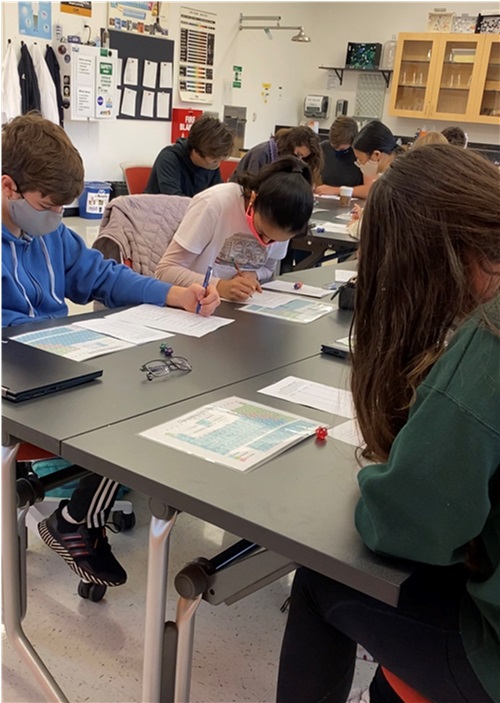
(1) coaches and reinforces peer-to-peer dynamics that are appropriate and constructive
Collaboration is a key part of my classroom culture with either explicit groups for projects and labs or informal interactions during warm-ups and practice time. In order to create an environment where learning from mistakes (and that also means admitting you made one) is a key to furthering your understanding, students need to be comfortable with each other. Creating opportunities for students to pair up or work in small groups allows students to work with different people (when I make the collaboration teams) or find the comfort of working with friends (when they get to choose). The interesting part of this is that students will sometimes observe that working with friends is less productive and, for longer more involved projects, has the potential to put strain on the relationship. When students work in groups with others when I choose the groups, a different discussion of group dynamics plays are roll. One of the major assumptions that I had early in my high school teaching career is that 10th graders would know how to collaborate. I have learned that even though they may have worked in groups prior to my class, they need guidance and feedback on what it means to be a good groupmate: contributing a fair share, not doing all the work yourself and maintaining active communication within the group.
Snippet from John’s Classroom Observation

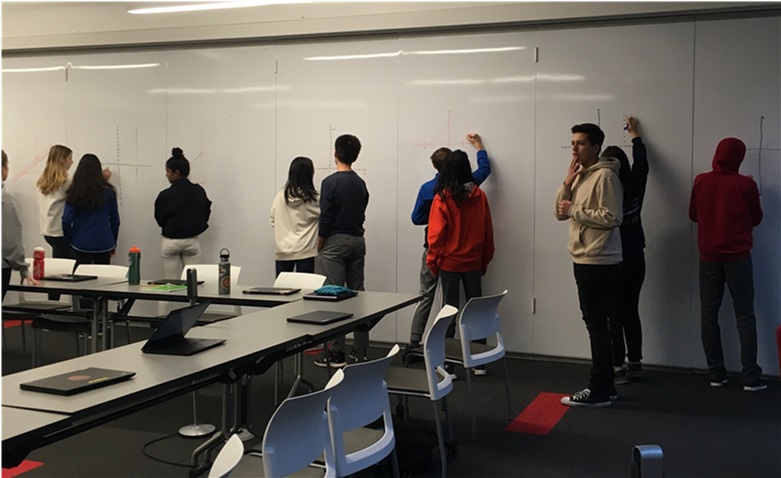
(2) communicates behavioral expectations that are appropriate to class activities
Behavioral expectations in a chemistry classroom come in two forms: Lab safety and normal classroom dynamics.
- Normal classroom behavior again is something that I communicate early in the year in terms of expectations for classroom behavior including bathroom protocol, food, respectfulness, etc. I don’t often have to remind students of these at EPS. We have really good kids that will even thank me when I hand them a quiz or test!
- I spend most of a class period at the beginning of each year going into depths of lab safety. The students and their parents sign a safety contract and the kids take a safety quiz. But as you can see from the snippet below, I can’t remember a lab period where I have not had to remind students especially about where their goggles covering their eyes and not their forehead.
Snippet from Bart’s Classroom Observation:
“Came into class a couple of minutes late- AD already off and running. Attention of class was outstanding- everyone focused and following
- Giving directions for the day, very clear to me
- At 8:05, class sets off on lab for the day, kids move with good speed putting on lab coats and getting set up- clearly well trained in this procedure
- Well, all but Tristan? Notice he has not yet put on coat- and then AD tells him to do so!
- 8:08 and everyone is at their stations- nice work
AD doing a good job moving all over- kids are checking in with her, too. They seem to leave each conversation with clear understanding.”
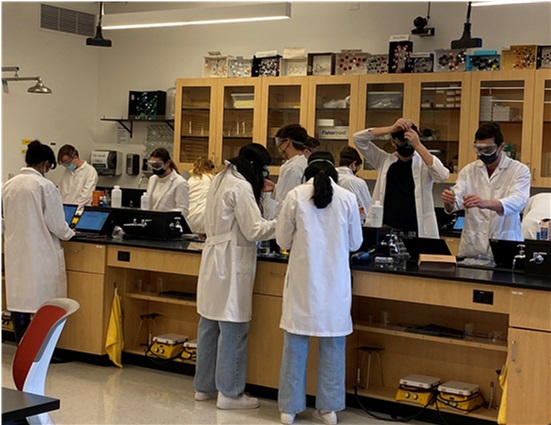
(3) develops a mutually respectful relationship with each student, instilling confidence that the teacher is invested in their success
Building relationship with my students is one of my primary goals. This is based on the philosophy that the teacher/student relationship is built on mutual trust and respect. Students need to trust that I know the content, that I know how to deliver content, that I provide fair assessments and that I have their best interest at heart. Even though it was more difficult to do this remote, I added informal check-in questions at the beginning of each lesson that gave us a way to share about ourselves and our preferences that were mainly not about chemistry. I have continued the check-in questions even with in-person learning as they fill a gap that I didn’t know was missing before COVID. During lessons, I will share stories or preferences or off-topic thoughts to allow students to get to know me. I encourage students to set up meetings with me and come to office hours encouraging the relationship building through content learning. I hold regular office hours during middle bands on Wednesdays and Fridays but am also available during student free periods. These opportunities are most often attended before a quiz or test as you see the advanced chemistry students working with me during a study hall in the LPC just before their test that day.
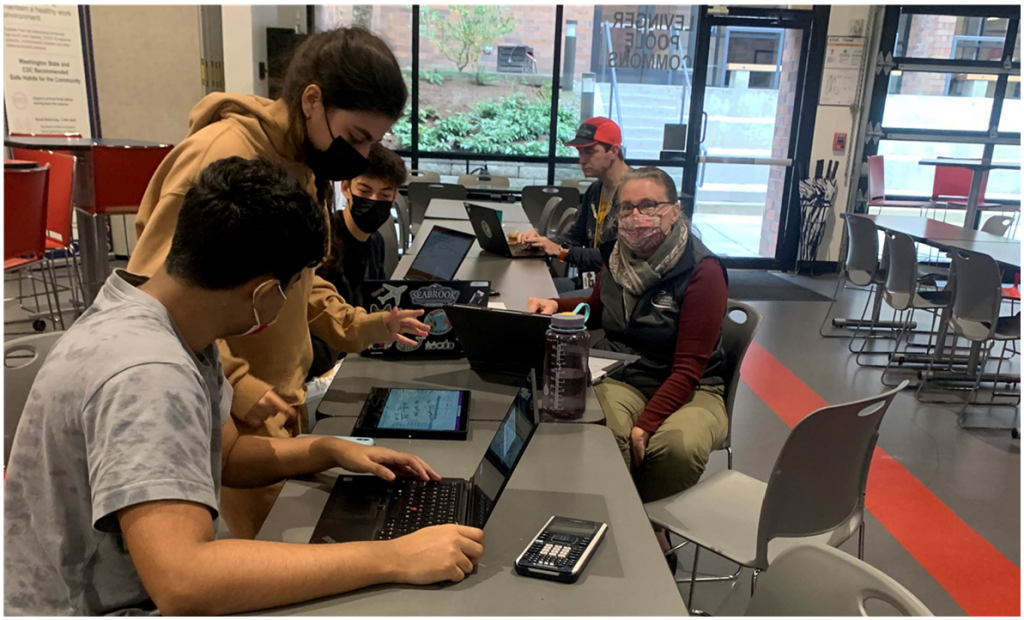
I will say sporadically throughout the school year that I teach high school because I am interested in helping students develop as people. If I just wanted to teach chemistry content, I would still be teaching college. Besides what happens surrounding chemistry, I make an effort to attend events like sports and arts allowing students to see that I am invested in their education beyond the classroom and themselves as people. I love chaperoning prom since I get to see the kids all dressed up and have more informal conversations towards the end of a school year. For the daily interactions when we are on campus, I do my best to address every student by name when greeting them in passing.

Beyond the obvious advantages for building relationship with students that has been well documented in education research (for example, see Longobardi, C., Settanni, M., Lin, S., & Fabris, M. A. (2021). Student–teacher relationship quality and prosocial behaviour: the mediating role of academic achievement and a positive attitude towards school. British Journal of Educational Psychology, 91(2), 547-562). For me personally, it is important because I have a tendency to be very direct in my feedback which can be misinterpreted by students as seen below.
Snippet from John’s Classroom Observation:

In the excerpt above, this is the type of comment that I would be very cognizant of saying early on in the school year as it is harsh and perhaps too direct. However, as I build relationship with students, some student may benefit from such a direct reminder if they, in fact, rarely use the resources provided before asking a question that would be obvious if they did. The intent here is often to help students develop into self sufficient productive members of society well past school years. In a survey sent to colleagues in preparation for my PDP, Katie Dodd saw that and wrote, “Anne thinks a lot about how her students will fare once they leave EPS, and she’s incredibly dedicated to making sure that they have the skills that they need to be successful in college and beyond. This means that Anne does not shy away from challenging conversations with students, all in support of their future endeavors. I can’t think of a better way to represent our school than by equipping our alumni with what they need to succeed in the world.”
(4) demonstrates cultural competence by promoting inclusivity
Being a woman in science and trained in a field (organometallic chemistry) that was male dominated, I have always been an advocate for women in science and in under-represented fields of STEM. I am well versed in this area and share personal stories as well as stories from the history of science and current events (See examples below). Because of my personal experiences, I tend to gravitate towards this area when it comes to inclusivity. That being said, I know that there is a lot of area to expand in order to include not just women but minority populations as well. This will always be a work in progress for me.
Various Stories/Comments throughout the year:
- Fall Tri: Discovery of oxygen attributed to Lavoisier but really his wife did all the lab work AND wrote his papers. He was the face of her work in the latter part of the 1700’s. The play “Oxygen” by R. Hoffmann and C. Djerassi addresses the controversy of who discovered oxygen between three men but includes the fact that the women (wives of two of the three) were involved in sharing of information and in Lavoisier’s case completing the experiments. http://www.roaldhoffmann.com/oxygen-synopsis
- Anytime a reaction or law is named, I often talk about the history and the necessity of naming versus the application of their work. This supports an underlying theme that I have in discussing the history of science in that it was often the privileged that had access to the education and materials: this was often white men in the development of chemistry.
- I also include current highlights especially when it involves awards for women and/or POC. For example: CRISPR-2020 Nobel Prize in Chemistry
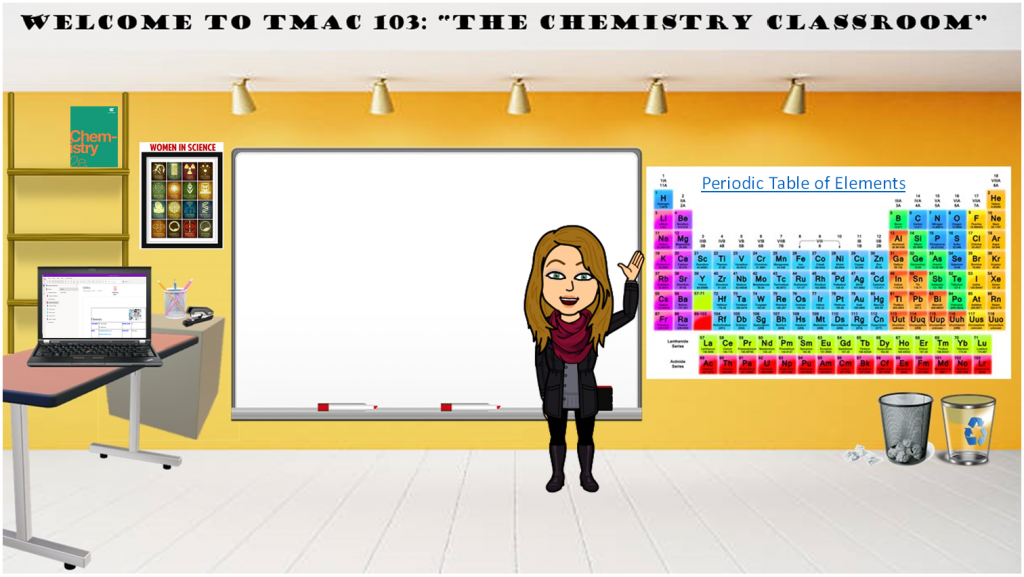
(5) designs and facilitates a classroom culture that promotes student preparedness, engagement, self-advocacy, perseverance, and collaboration
One of the cornerstones of my practice is “Less of the teacher. More of the student.” With this in mind, I build into my lessons the least amount of me talking and as much as I can, students doing something active related to the lesson. One way to do that is to encourage collaboration. I do this in two main ways: 1) forced collaboration where I assign groups to complete a lab, activity or project; 2) informal collaboration where students work together on warm-up problems or practice usually with peers seated near them. In both areas, I have found that students need guidance and reminders on what collaboration is and what it is not. The images below are from an activity that Steve Fassino and I do the first day/week of school in Algebra 2. The kids are in groups working on a task where there score improves with better collaboration. We go through three or four rounds and discuss in between each around, patterns they observed in the task but mostly patterns they observed in their collaboration. During these rounds, we take pictures of the collaboration. In the next class period, we show the kids the pictures of themselves (making sure that I have images of each student in a group) and we talk about what good group work looks like. The kids come up with a list of observable traits and non-observable traits that I right down on the white board. The great part about starting the year this way is that we can come back to that list and/or images and just ask “what does good group work look like?” if ever the kids start to stray a bit.
In chemistry, I start the year off with lab safety given the goal of having them doing a lab as soon as possible. Even though that first lab still requires students to work in pairs, I spend less time explicitly discussing what good collaboration looks like. This is something that I am definitely considering including especially in the lab arena where I occasionally see students relying heavily on a lab partner. Having the Algebra 2 students taken ownership of what good group work looks like has more buy in and student investment than me telling them to do things differently, which is basically what I do in chemistry. One of my hesitations for the lab component is to build student confidence in performing labs so then finding out why they are relying heavily on a lab partner matters. The last thing that I want to do is push someone to do something when they do not feel safe or confident especially at the beginning of the year in chemistry.
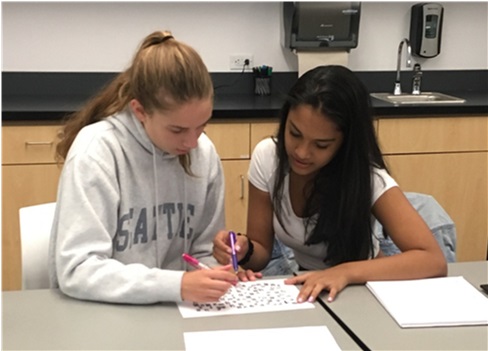
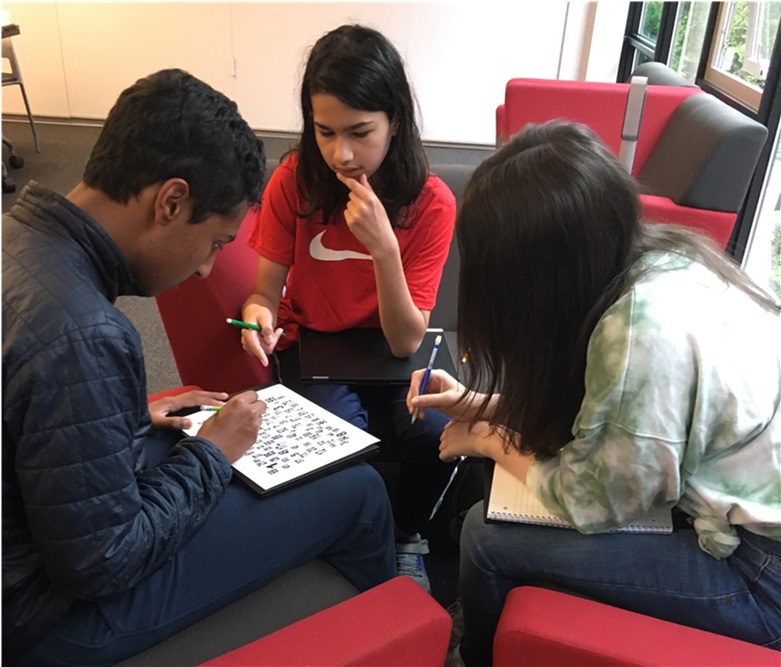
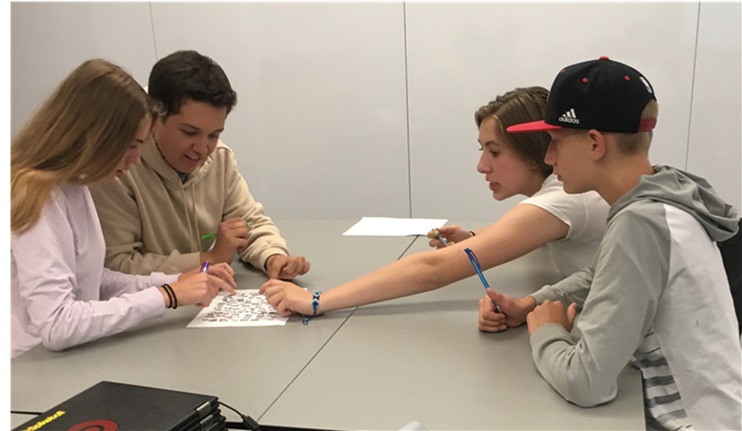
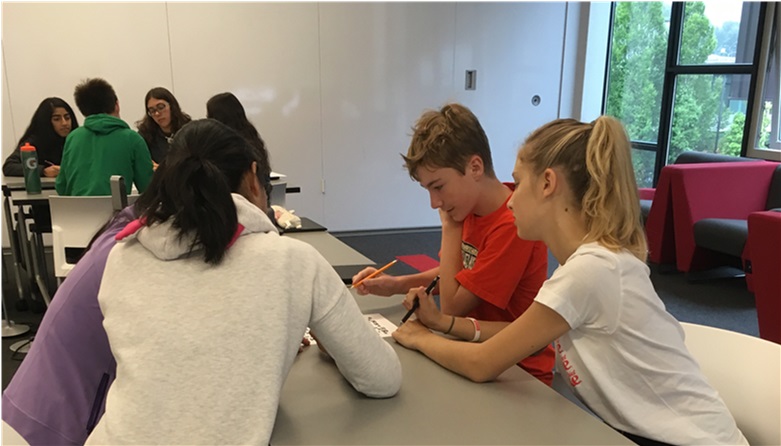
Quote from Bart’s Classroom Observation:
“I’m really pleased by the noise- it feels just right. Kids are talking and interacting, but in quiet, calm manner. Clearly not getting in the way of progress and the class objectives.”
Snippet from John’s Classroom Observation:

Snippet from Elena’s (my PDP Facilitator) Classroom Observation:

Snippet from Terry’s Classroom Observation (remote):

Pedagogical Effectiveness
My overachieving philosophy with the daily pedagogy is “Less of the teacher. More of the students.” Although there are rare situations where I will give a lecture type lesson that lasts more than 30 minutes, even in those situations, there are lots of pause for students to engage, question and interact. As I plan each daily lesson, I explicitly build in time for students to be doing something active with the goal that at least half of the class is devoted to that endeavor. Ah, you may say that this is easy given that I am a chemistry teacher and that every lab is an activity that lends itself to “doing ´something active. This is true, yet, building the scaffold from which the student approach a lab is important for their ability to make connections to the concepts and not completely “cookbook” the lab experience.
As you will see in the pages below, the daily experience centers around students’ engagement and active participation. In my opinion, the few students that are processing new information during a lesson enough to ask questions does not represent the whole of the class. As a result, the time that I build for practice in class is important to give all students a chance to engage with new material, make connections with past concepts, work with their peers and be able to ask questions from their teacher as they build new knowledge.
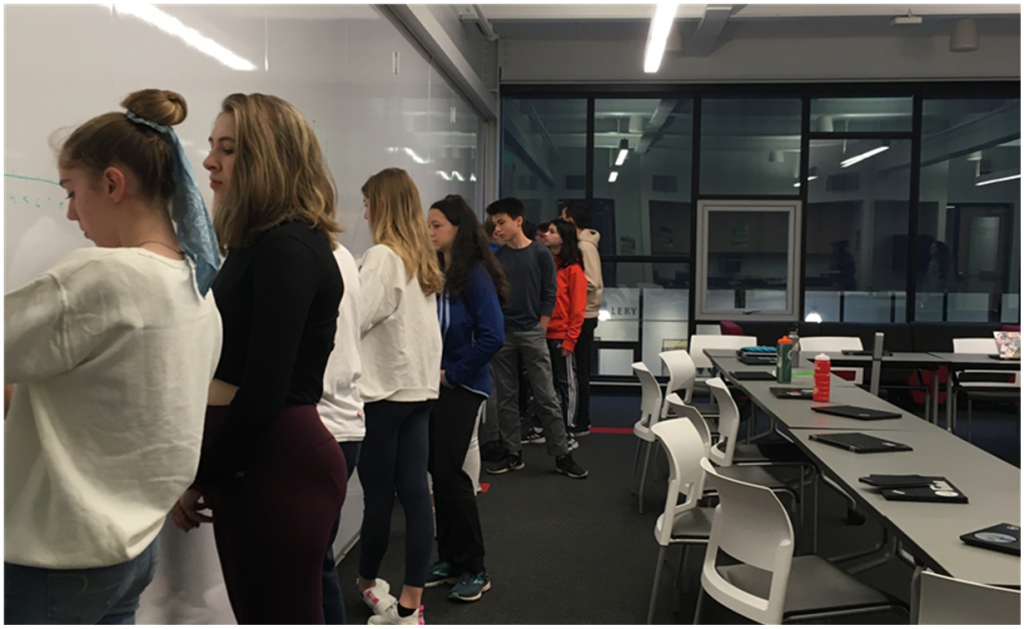
“Less of the teacher. More of the students.”
(1) begins class sessions with a clear statement about the lesson’s objectives and place in the progression of course
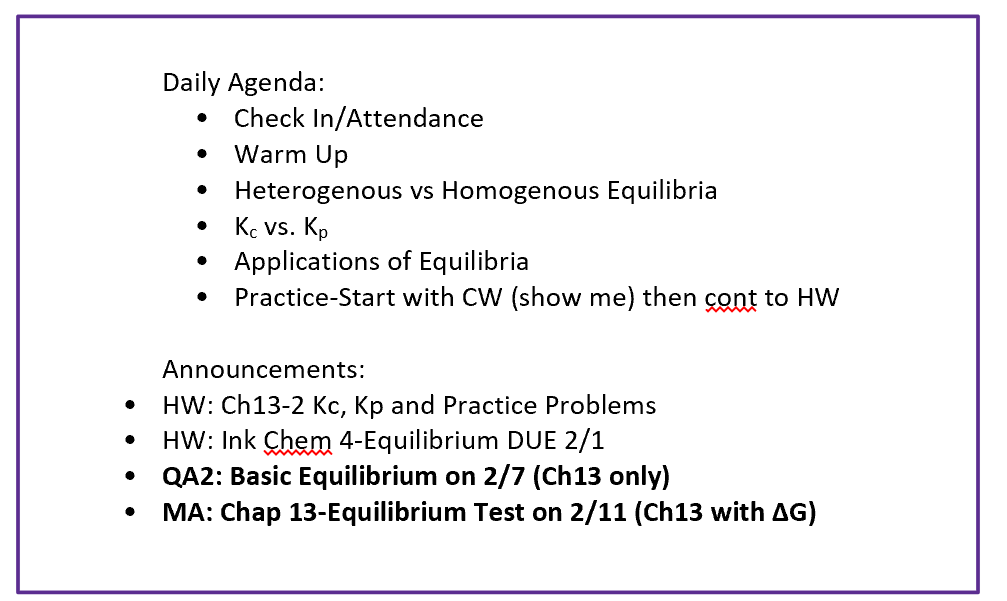
I start each class with an Agenda/Announcements section at the top of the daily OneNote page.
- The check in question is something that I started when we were remote but have continued in person as it gives an informal way to start class but also gives us insight into each student. These range from short (what’s your favorite candy?) to more involved (How would you spend a lottery winning of $1000).
- The Warm-Up connects the current lesson to what we did last class period
- The first topics expand learnings from last class (Het vs Hom Equ and Kc vs Kp). The vs means that I am connecting something from a previous lesson to something new.
- New Material (Applications)
- Time for Practice
- Announcements are related to upcoming events in Canvas
Quote from John’s Classroom Observation:
“Groups are pre-assigned on the board-love it! Very clear agenda projected for today’s activities.”
Quote from Terry’s Classroom Observation (remote):
“Comfortable warm-up question – great way to get the session launched – and to include everyone.”
(2) designs and implements varied activities in each class period
In this example lesson from the “Daily Agenda” above, the check-in sets a tone that helps remind us that we are a group of people coming together to learn chemistry. We are humans that have similarities and differences. This helps reinforce the classroom culture in terms of a space to be safe and vulnerable.
The warm-up gets their brains going in the realm of chemistry reminding them what we learned. The work individually but are allowed to chat while I walk around to answer questions and view solutions. If I see some different approaches, I will ask those students to share when we discuss the warm up.
The lesson (bullets Het, Kc and Applications) are mainly a lecture but one that stops for questions even if no students asks. There are points in this section that I pause and wait for questions based on past experience and years of teaching. It rarely happens that I have no questions so I can wait longer when needed until someone asks or comments.
The practice time is super important. This is a time that they can apply NEW content in a safe environment where they can ask questions of each other and myself. I often post a key to what they are working on so they can check answers resulting in the questions are more aligned with approaches and conceptual understanding instead of “is this correct?”
Snippet from John’s Classroom Observation:

(3) brings each activity to closure effectively and transitions intentionally to subsequent activities
Transitions can be tricky when you build a class environment that encourages discourse and peer interactions. Not every student or group will complete an activity at the same time so, depending on the intent of the lesson, transitions have to be done with the varied pacing as well as the active classroom in mind. In my mind, I sort activities into three main categories: warm-ups, inquiry-based with self/group pacing and practice.
- Warm-ups are built so that every student has a chance to review material from a previous class even if they don’t through ALL of the warm-up. The number and/or order of the warm-up questions allows for students to have enough practice to appreciate where we are going for that day’s lesson. As I transition from students working to sharing answers, I make it clear that students still working are not behind (since I have walked around and seen that each student has gotten through the main part of the warm-up). I post the solutions to OneNote so students who do complete the warm-up later still has a chance to benefit from what was shared in class.
- For inquiry-based activities, most of the lab activities but also includes some structured lessons using from “Chemistry: A Guided Inquiry” By Moog and Farrell, I structure the time for students to work in partners are small groups. These groups or partnerships are switched regularly so that students benefit from working with a wide range of people. These activities are self-paced so students will finish at different times depending on either their level of preparation ahead of time (mainly for labs) or their general understanding and collaboration as a group. For these activties, the often take up most of a class period with students that are done earlier than others having the opportunity to start on the homework.
- Practice is common after introducing a new topic with examples and then allowing students to work in class. No groups are assigned. They can work alone or with peers. This is also self-paced and often towards the end of the lesson. Although I do pause is some lessons to give students some intermittent practice when it is valuable for them to understand more deeply before I move forward in the lesson. In those instances, transitions are similar to the warm-up above.
For the last two (unless otherwise noted), I do not have explicit transitions as these take most of the class period or the final part of a lesson. In those instances, I often know where each individual student is in their understanding by the end of the lesson and have even given them some individual guidance on what to focus on for homework. The final word at the end of class is often a reminder from the announcements.
Snippet from John’s Classroom Observation:

(4) ensures that students are using technological tools effectively
Although our students at EPS are very proficient in the use of Canvas, OneNote, Word etc, they at times need support in how to use some of the tools at their disposal in an expanded way. I spend a significant amount of time in Advanced Chemistry teaching the kids many functionalities of their graphing calculator. An example below comes from a recent lesson where we spent class time understanding how to use the solve function on their graphing calculator. In Algebra 2, they learned to solved quadratic equations step by step. In Advanced Chemistry, the time that it takes to do the step-by-step method is not time well spent compared to the chemistry concept introduced. The boxed equation below can be put into their calculator that will solve for x that then the students can use to answer the chemical question at hand.
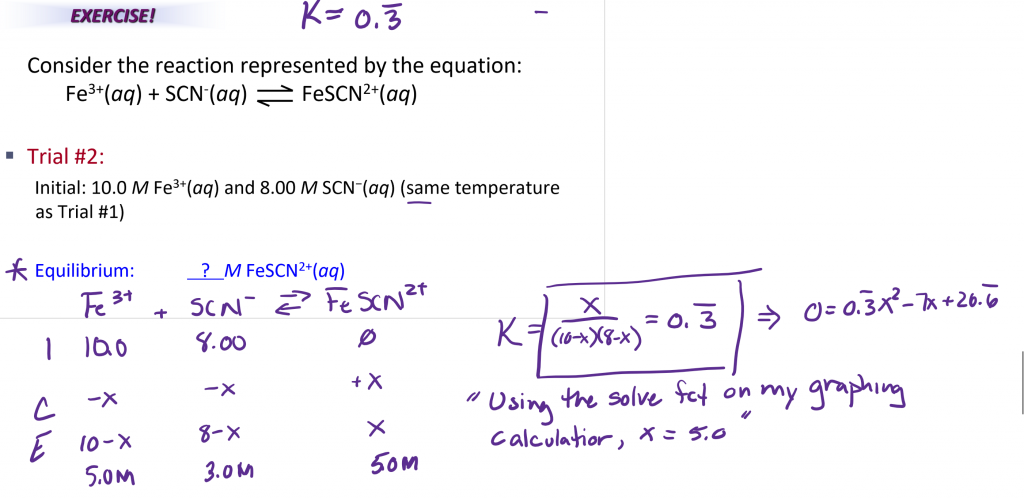
(5) concludes class with a summary and clear tie-in to the next class
I publish a calendar at the beginning of each trimester (see snippet below) to discuss the flow of the trimester. I often go back to that at the beginning of a class to show students where we are and were we are going. Since I build in time for individual work, the way that I conclude class is more a reminder of what I had said at the beginning of class. This is helpful not only in creating the connections but it also helps for kids who will miss class or have to leave early for whatever reason. Although I don’t explicitly outline a summary of the lesson or tie-in to next class, the students have been usually working on practice for that lesson and can see where we are going from the calendar. The final word at the end of class is often a reminder from the announcements from the daily agenda as I dismiss the kids from class.
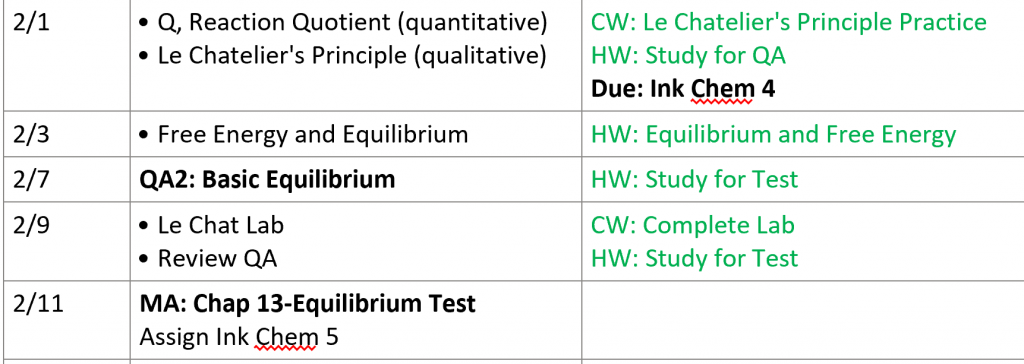
Differentiated Instruction & Assessment
Differentiated instruction and assessment in my classroom happens through building relationship with students to give them the attention that they need to demonstrate their learning and build their confidence as problem solvers and scientific thinkers. Every student is unique. Some have diagnosed learning differences while others have diverse background of culture, socioeconomic status and family. Although there is clear research in how to support students with some learning differences and research on how to support students, for example, who are English Language Learners, my approach in the classroom is to empower the students to learn about their own learning and develop stronger metacognition. There are explicit protocols that help students do just that. At times, I have used those but I tend to stay away from heuristics that kids see right through as a procedure to help them learn and share. My focus is mostly based on building relationship with the students and through that help them understand that I care about their learning but, more importantly, their growth as a human beyond what we do in the classroom. How do they deal with conflict? How do they overcome getting something done when they don’t want to do it? How do they stay productive when they feel buried in a mountain of asks? The subjects that I teach are science and math but mostly chemistry. If I cared about teaching the content the most, I would still be teaching at the college level. What attracts me to teaching high school is the teaching “education beyond the content.” I teach resilience, grit, critical thinking, interpersonal skills, communication skills and collaboration. The differentiation happens through providing multiple axis points to engage with materials, multiple ways to show growth and learning and multiple opportunities for formal and informal feedback. Since all of the kids are unique, I work to develop relationships to get to know them on a personal level as best I can and through that am better able to support them as unique individuals. Some kids need to hear “no” more while others need more “yes.” I strive to be very fair in my assessment opportunities and fair can be defined slightly differently for different circumstances. I have even at times modified a group project to be an individual project when that made the best sense for that student. For example see Global Climate Change Project Modified for an Individual. The end goal is that each student grows in their knowledge of chemistry and in their knowledge of what they are capable of to tackle on the challenges beyond my classroom.
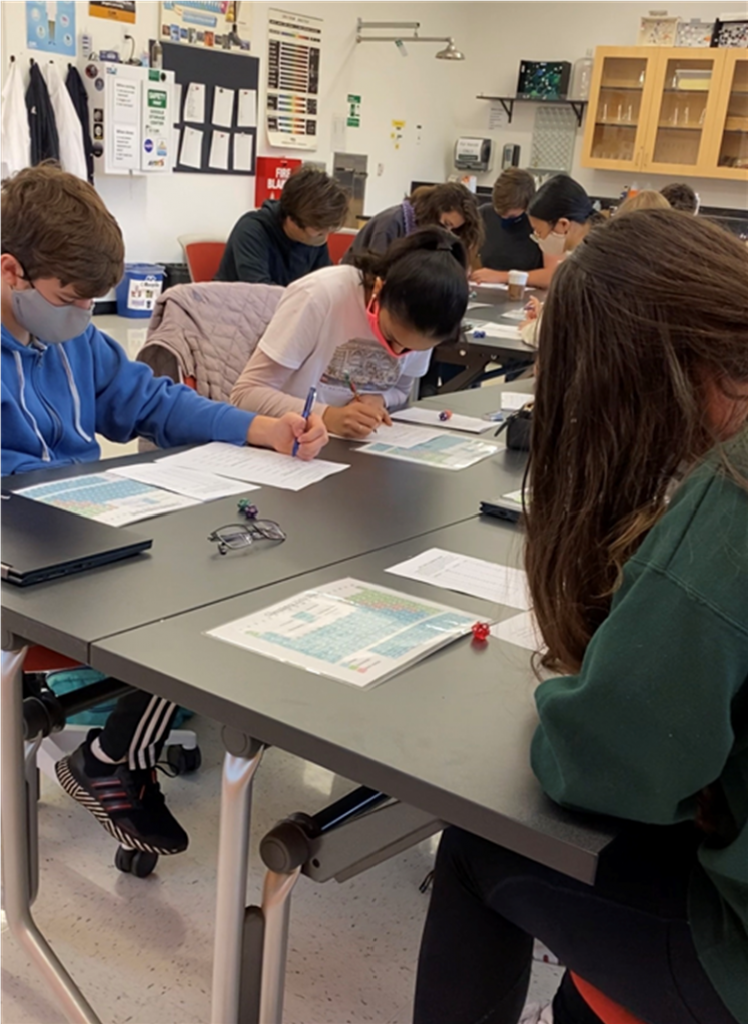
(1) considers and addresses each student’s learning profile
This is definitely an area that I see as an area of growth. I pay attention to this mainly for assessments. Most of this is done again as I build relationship with the students. As they become more comfortable, they do better at self-advocating and even brainstorming with me approaches that will help them succeed in their goals. I do consider how kids will approach the curriculum in a general sense considering the diversity of learners in the classroom. In the survey of colleagues conducted for the “Relational Cultivation” domain, one collaborative peer, Krissy Russell, states, “a general characteristic of Anne is that she is a critical thinker. I’ve noticed her critical thinking often being applied to situations where she will provide suggestions for a situation considering various other viewpoints. For example: “What about the kids who…? Some of the kids don’t have access to…” showing that I think about the kids overall even before I know them as individuals. This is often the case when planning projects for fall trimester during the summer.
For one student in Advanced Biology, she had accommodations for extra time but found the format of the weekly reading quizzes difficult. I came up with the idea of increasing font size as well as giving more space between questions so she could use two blank sheets of paper to cover up everything else on the page but the one question that she was working on. The examples of both versions of a weekly reading quiz are below. Besides this, I have often created different versions of assessments for students with dyslexia if they agree that it would be helpful. I always make the decision to do something different for any student a conversation where the student has influence on any changes. As far as an area of growth, I rely heavily on student feedback and the interactions that I have with students to help provide the best support for their needs. Since this relies on the relationship with the student, this means that some students who do not engage to develop that same relationship with me may not be getting the support that they need to do well.
Original Version:
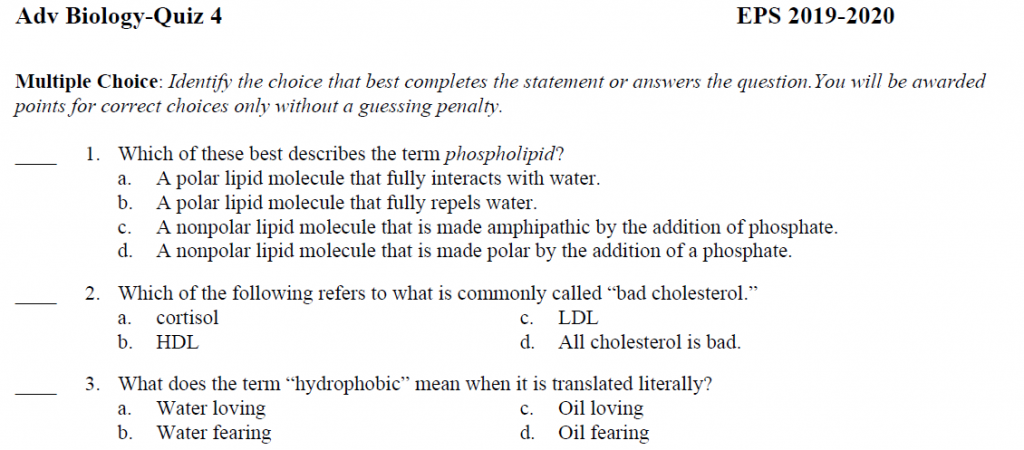
Revised Version:
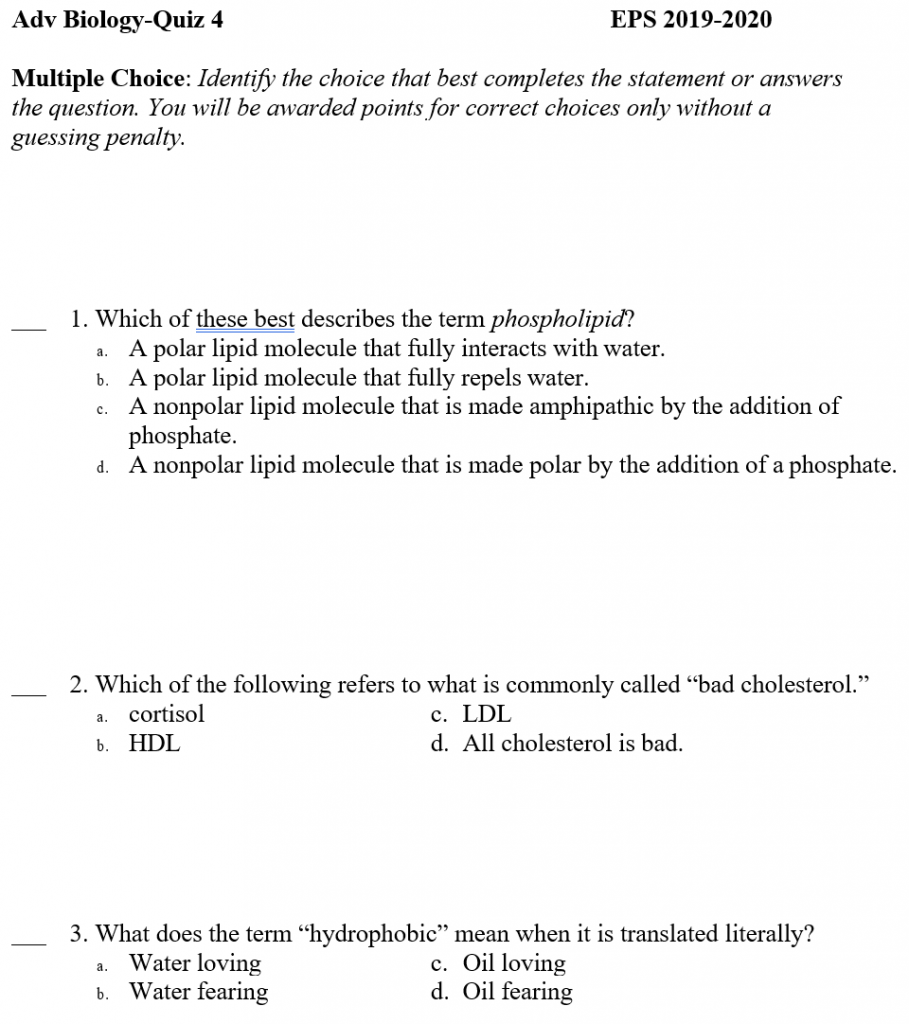
(2) designs class activities and assignments that engage and accommodate for both individual students and a diverse group of learners
Knowing that the students coming into Advanced Chemistry for the 2021-2022 school year would not have the lab background that the course requires, I designed a month of labs that I called a lab contract (Intro Lab Grading Contract) that would allow students to have some choice in what labs they perform, when they do which labs while also providing opportunities for them to demonstrate their learning along the way. Besides the class time allotted, I also had several open lab times during that month of lab so students that needed to repeat trials, had missed class or worked at a slower pace could still complete their selected labs for their desired outcome.
Grading breakdown for the Advanced Chemistry Lab Contract

The above information is related to the “Lab Contract” that I designed to bring students up to speed on their lab skills at the beginning of advanced chemistry after spending more than a year with remote learning as a result of the COVID-19 outbreak. Students spent the first month of the 2021-2022 academic year completing the lab contract with consisted of three required labs and four optional labs (of which they could choose up to two) that they could perform in any order over the course of four weeks.

Scaffolding and feedback was provided throughout the four weeks with students being asked to turn in their Lab Analyses for the three required labs on the day that they also took a quiz on the content of that lab. Again the order didn’t matter as all labs were prepped at the beginning of the month so the calendar above shows two suggested courses of action assuming students want to complete the “A Bundle.”
The purpose of the lab quizzes was to hold students individually responsible for the content knowledge since they had the option of work with a partner for each of the required labs. In order to make the quiz situation less high stakes, I had class time for two quizzes but if a student was unhappy with their performance on one of these quizzes, they could take a third quiz covering a different required lab that would replace the undesired past quiz grade. On the day of a quiz, students were also asked to submit the lab analysis for the lab activity that matched the quiz for that day. This gave me the opportunity to provide feedback on each of the three required labs. Students could then take that feedback and make revisions prior to the due date for the complete “Lab Contract Portfolio.”
This tables below help explain the grading process for each of the components of the lab contract and the flexibility that each component had. It gives more detail on what assignments were worth in terms of points as well as possibilities for feedback and revision.
The above information is related to the “Lab Contract” that I designed to bring students up to speed on their lab skills at the beginning of advanced chemistry after spending more than a year with remote learning as a result of the COVID-19 outbreak. Students spent the first month of the 2021-2022 academic year completing the lab contract with consisted of three required labs and four optional labs (of which they could choose up to two) that they could perform in any order over the course of four weeks.
Scaffolding and feedback was provided throughout the four weeks with students being asked to turn in their Lab Analyses for the three required labs on the day that they also took a quiz on the content of that lab. Again the order didn’t matter as all labs were prepped at the beginning of the month so the calendar above shows two suggested courses of action assuming students want to complete the “A Bundle.”
The purpose of the lab quizzes was to hold students individually responsible for the content knowledge since they had the option of work with a partner for each of the required labs. In order to make the quiz situation less high stakes, I had class time for two quizzes but if a student was unhappy with their performance on one of these quizzes, they could take a third quiz covering a different required lab that would replace the undesired past quiz grade. On the day of a quiz, students were also asked to submit the lab analysis for the lab activity that matched the quiz for that day. This gave me the opportunity to provide feedback on each of the three required labs. Students could then take that feedback and make revisions prior to the due date for the complete “Lab Contract Portfolio.”
This table below helps explain the grading process for each of the components of the lab contract and the flexibility that each component had. It gives more detail on what assignments were worth in terms of points as well as possibilities for feedback and revision.
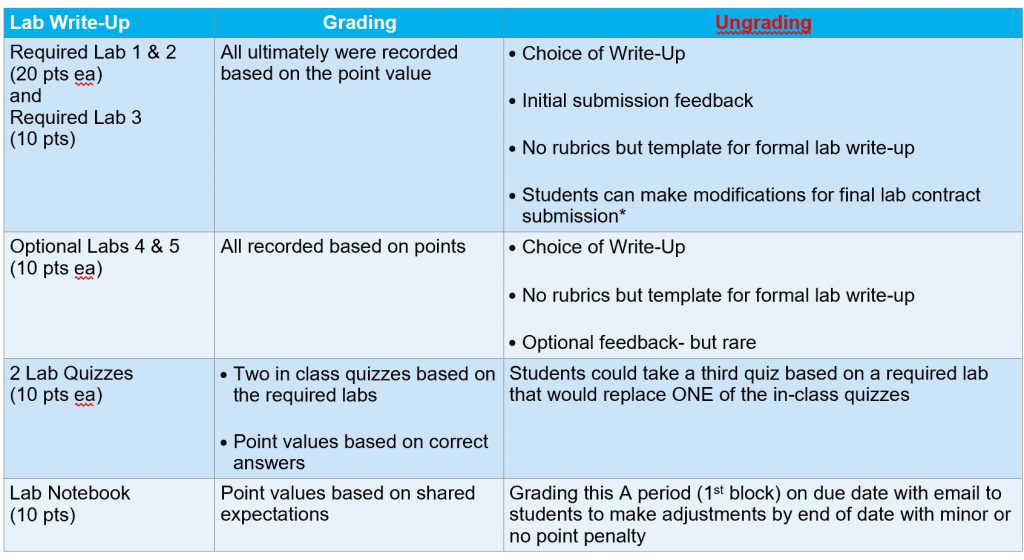
Examples of student work showing different approaches to a Lab Analysis for the Beer’s Law Lab:
Beer’s Law Written Lab Report by Claire Wu and Bennett Klusman and
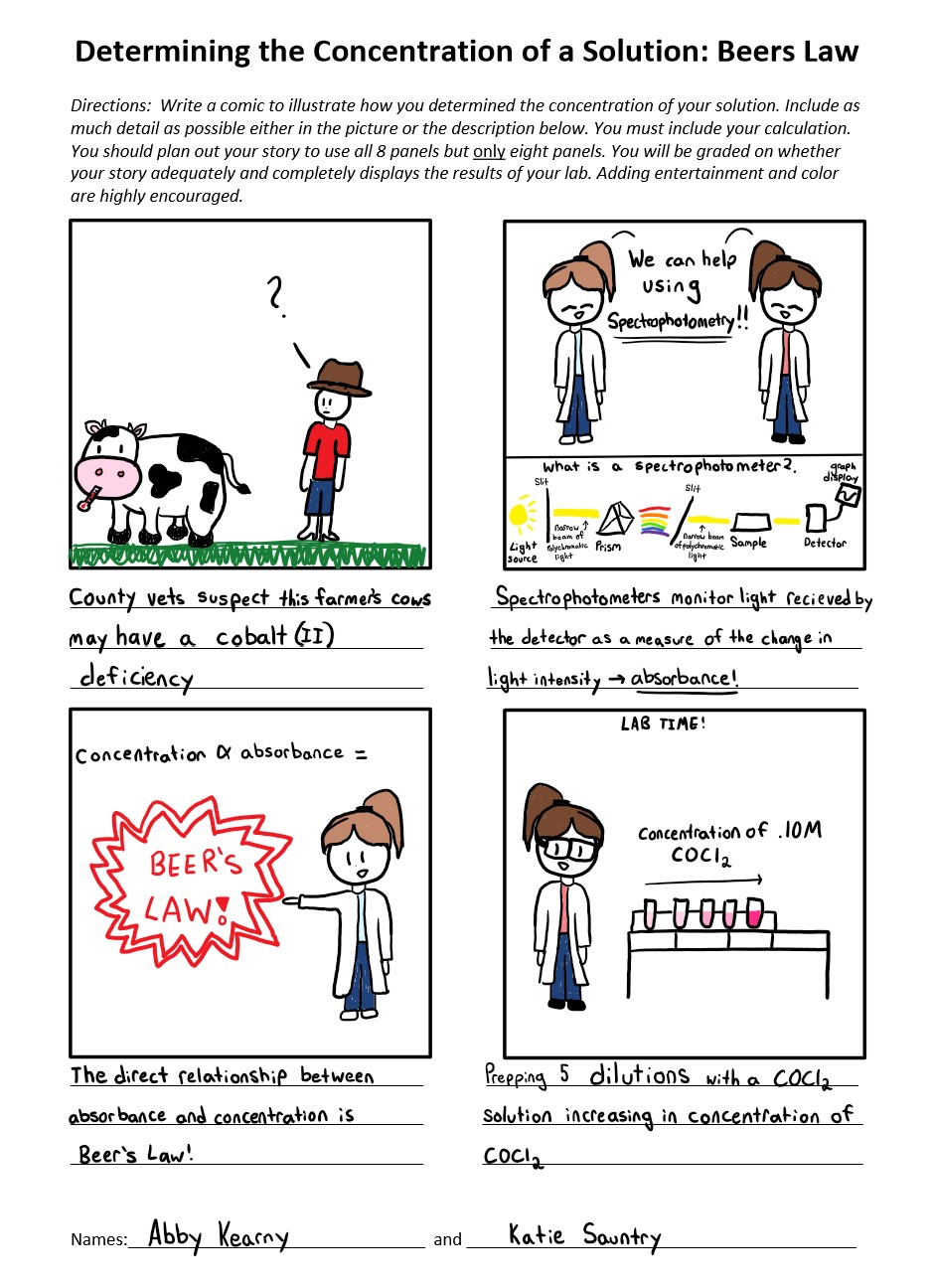
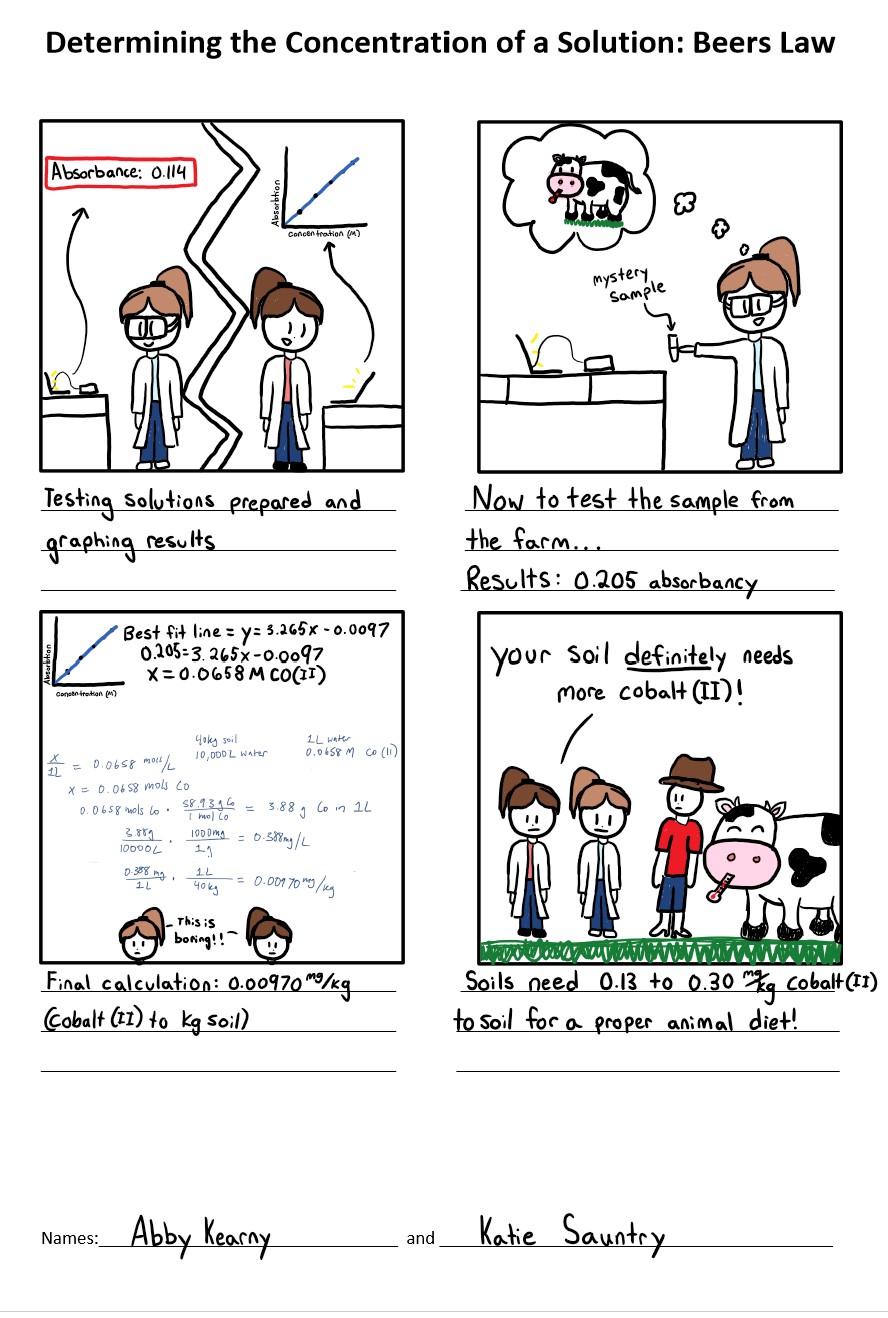
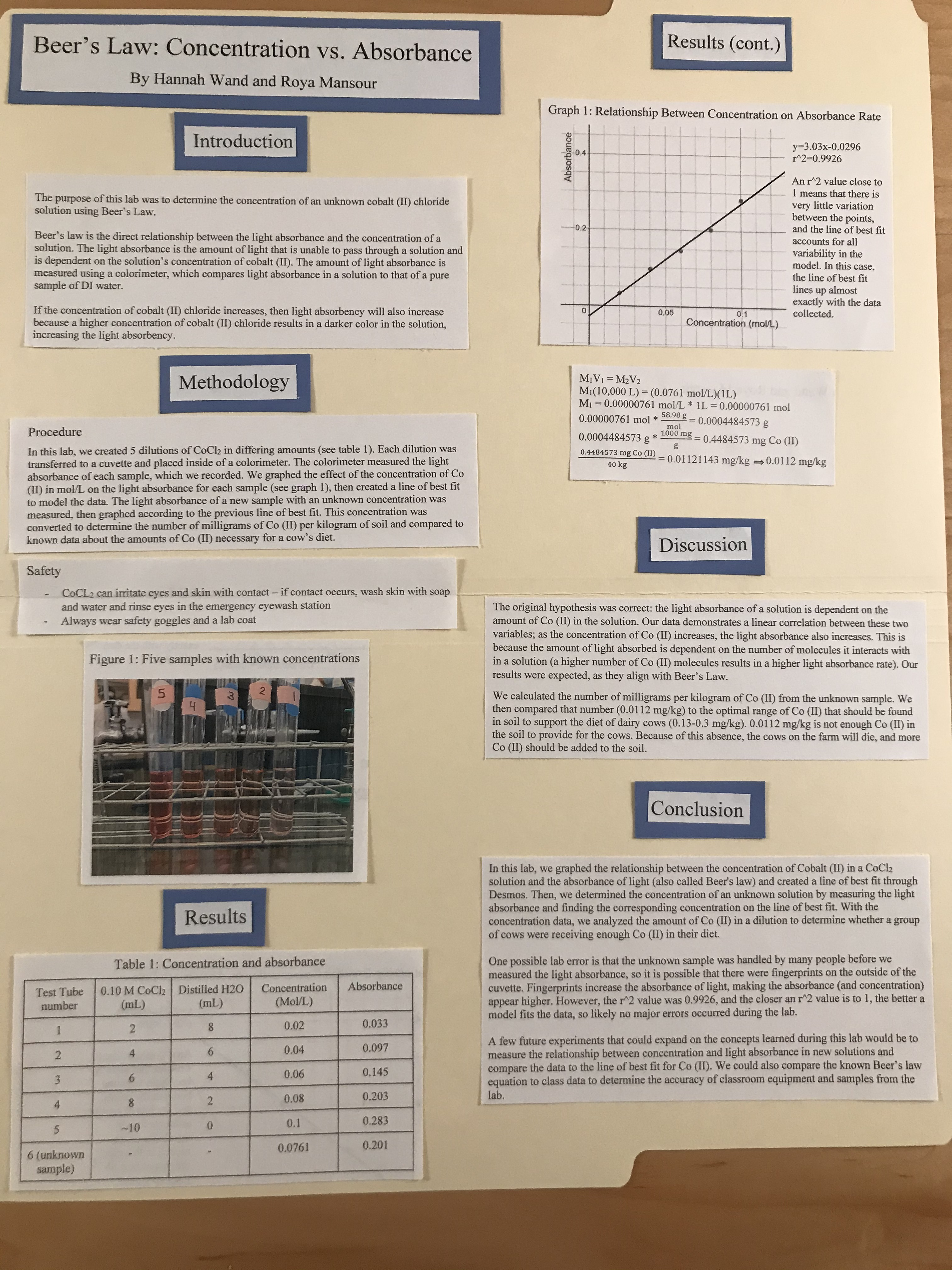
(3) builds in opportunities for each student to contribute during each class period
This is something that I make more explicitly part of the course in more introductory courses with 9th and 10th graders. In the early years of high school, I find that students need more encouragement to share their answers. In the advanced chemistry course, I have the similar opportunities but I am less intentional when it comes to having students share in front of their peers. In every class, I build in work time whether lab or practice where students all contribute their input in their table groups or with neighboring students. Below are examples of an intentional opportunity for chemistry students to share a solution to the warm-up. Here there is enough for each student to do one and for some students to do two.
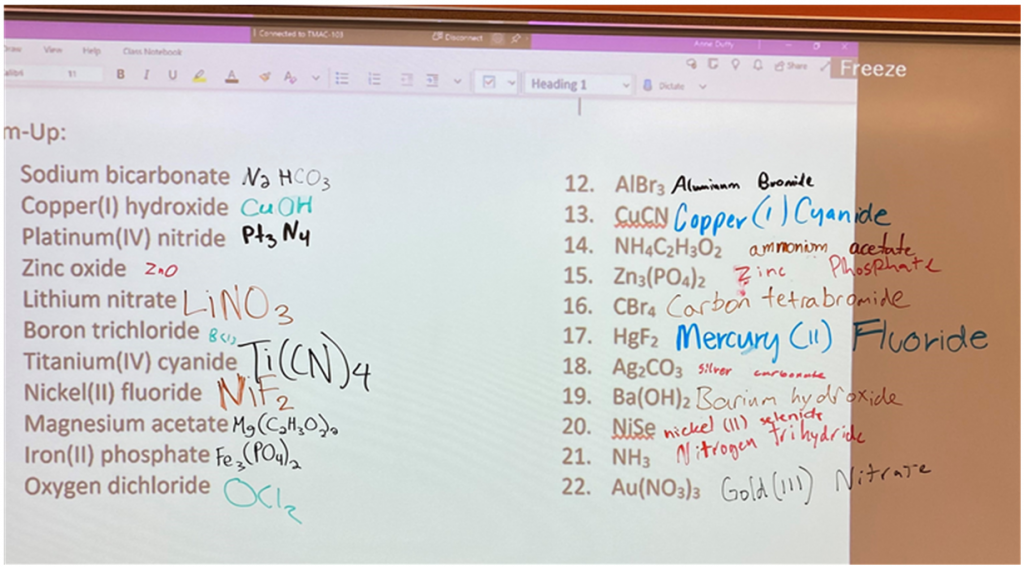
(4) provides alternative explanations of course concepts
As students learn concepts, I provide them with opportunities to apply their learning in different contexts. The alternative explanation is often tied to the applied experiences which can often take the form of completing lab investigations, case studies or other inquiry type activities. Each of these experiences gives the students the opportunity to see how the concept is applied in real world scenarios. I model the importance of communication in science in all my interactions with students working hard to meet them where they are to help them improve their understanding. To solidify that importance, I provide multiple opportunities for students to practice their communication of concepts as seen in the examples below.
Students in 10th grade chemistry learn about different reaction types and the math beyond chemical reactions called stoichiometry. The explore the six different types of reactions in one lab period prior to learning about stoichiometry and, in the 6th/10th grade project choose one reaction type to become an expert in so that they can explain this reaction type to 6th graders. This gives the students the opportunity to present their learning so that it is understandable to 6th graders but also themselves at a deeper level. As you see below, before the present to 6th graders, they have a chance to present to their peers and receive feedback. Providing this opportunity for 10th graders shows them directly how important communication is in science.
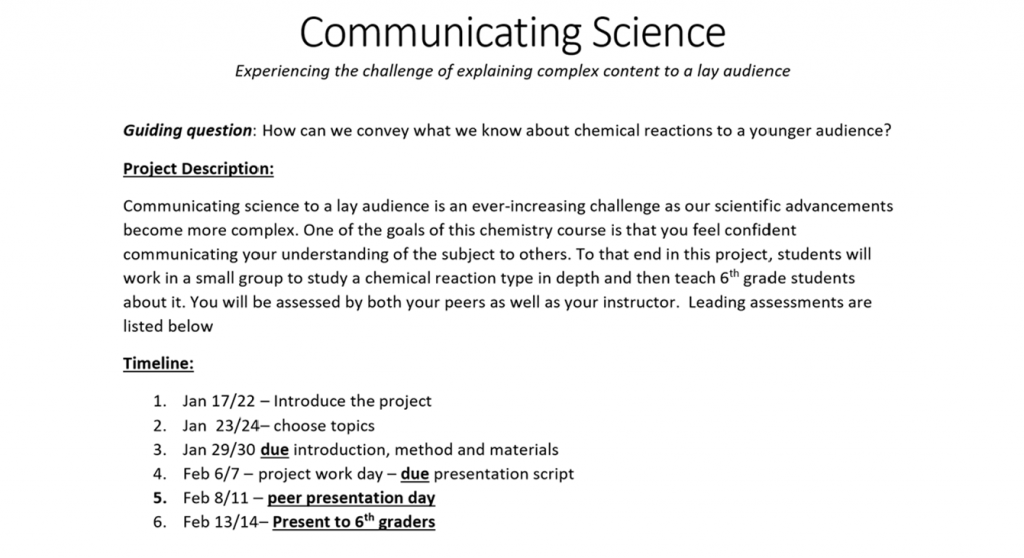
They ground their knowledge in chemical reactions before we introduce stoichiometry so that they have a reason for learning the math behind the chemical reactions. Inevitably, the students will ask something like “how much” is produced or required or lost. The answer comes in stoichiometry. Once their they then have several opportunities to engage with applying stoichiometry to real world scenarios. Two examples are below.
Hard Water Lab had the students design a procedure based on their prior knowledge to determine the water hardness of a given household sample and then make a recommendation on whether a water softener would be a good investment.
Snippet from client letter:

Full Client Letter as an example of the complete student work.
(5) adapts instruction based on formative assessment

The “NOTE” above is key to demonstrating my thinking here. In order to have time in spring trimester for open ended labs and a final project at the end of the year, I need to start new material towards the end of winter trimester that will not be on the students’ winter final exam but is foundational for the work that we will continue into spring. Before I can get very far on new material in the spring trimester, I need to know what students’ remember and can do from that week towards the end of winter trimester. So the original plan was to start the spring trimester with two short quizzes that will give me an idea of what the students understood and what may be lacking. Our final unit of the year, ties together many concepts over the two years of chemistry so I end up building in smaller assessments that gives me information about where the students are at in their learning and perhaps what I need to spend time reteaching.
Due to constraints with assigning HW due during finals week and students concerned about starting the spring trimester with TWO QAs in the first week, I made the following adjustments.

Here I made the lesson on 3/1 shorter followed by the first short QA being the Thursday before break. The students had 30 min of class time to start HW and ask questions. The lesson on 3/3 will not include work time during the class to cover the material but students will have the chance for the first day of spring trimester to be devoted to going through questions on the HW on which the second short QA will be based. The importance of each of the two QA’s is to make sure that the students have a solid foundation moving forward AND, if they don’t, I will know about it and can reach out to those students.